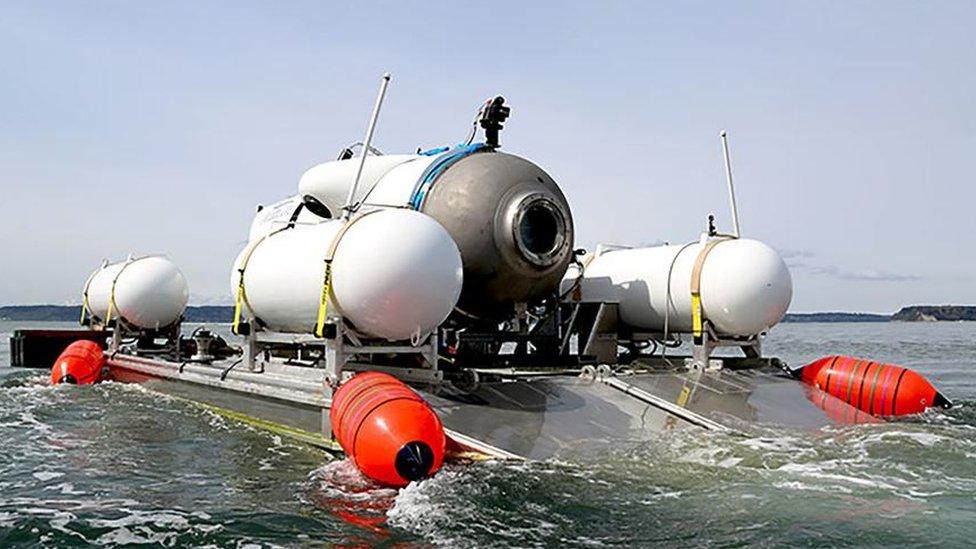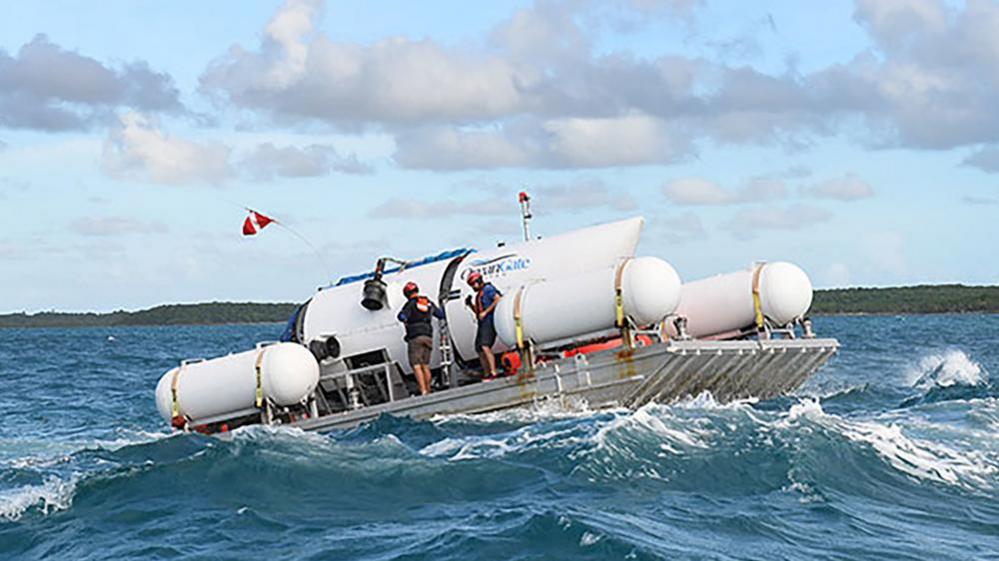Titanic sub search: What happens next
- Published

Many questions remain about what exactly happened to OceanGate's Titan submersible
US authorities have confirmed the loss of the submersible Titan, which went missing during a dive to the wreck of the Titanic nearly a week ago.
All five men on board were instantly killed in what they called a "catastrophic implosion" (a violent collapse inwards).
But many questions about what exactly happened remain, and calls are emerging for a full investigation.
One of those raising concerns about what happened is Lucy Cosnett, the cousin and goddaughter of Hamish Harding, one of the men on board.
"There should have been more safety checks done. The company OceanGate should have done more," she told the BBC.
"It should be fully investigated, to see what went wrong, why it happened, why they didn't survive."
Will the bodies be recovered?
US Coast Guard Rear Admiral John Mauger said on Thursday that he could not confirm if it would be possible to locate the bodies of those who died.
"This is an incredibly unforgiving environment," he said.
Those aboard were the wealthy British businessmen Hamish Harding and Shahzada Dawood, whose son Suleman joined him on Titan.
OceanGate CEO Stockton Rush was also part of the crew, alongside former French navy diver Paul-Henry Nargeolet.
You can find more information about their lives here.
What will happen with the search?
It is unclear at this stage which agency will lead the investigation as there is no protocol for such incidents with a submersible.
Rear Adm Mauger said it was particularly complex because the incident had taken place in a remote part of the ocean, involving people of different nationalities.
But having had a leading role in the operation so far, the US Coast Guard is likely to play an important part.
It said it would continue to investigate the site of the debris field. Vessels and technicians remain in the area. Other teams were slated to begin demobilising on Friday, however, with equipment that is no longer necessary withdrawn.
The remote operating vehicles (ROVs) sent to the sea floor around the Titanic will also remain for now.
"I don't have a timeline for when we would intend to stop remote operations on the seafloor at this point," said Rear Adm Mauger.
Pelagic Research Services - whose ROV discovered the debris field - said on Friday it was sending the vehicle down again to continue mapping and to document the area, as well as to help with debris recovery.
A company spokesman told CNN that the firm plans to remain onsite conducting ROV missions for another week.
What about clearing the sub debris?
It will be essential to gather up as much of the debris as possible, including bits of the carbon fibre that part of the vessel was made from, so authorities can build up a picture of what happened.
Efforts are continuing to map the area in which parts of Titan were found.
Paul Hankin, an undersea expert, said that five main pieces of the sub's hull and exterior had so far been recovered, including the nose cone.
Watch: What debris has been found and what does it mean?
It is unclear what condition the remaining parts would be in.
How will the incident be investigated?
On Friday, federal transportation agencies in Canada and the US said they would investigate the incident.
In the US, the probe will be led by the National Transportation Safety Board (NTSB) and the US Coastguard, the NTSB said.
The Titan was launched from the Canadian-flagged Polar Prince. Canada has dispatched a team of investigators from the federal transportation agency to Newfoundland to conduct interviews and in a statement said it would coordinate with other agencies.
The US Coast Guard's Rear Adm Mauger said on Thursday that governments of countries with connections to the incident have been meeting to discuss what an investigation could look like.
Those involved in any inquiry will be seeking to confirm the theory that an implosion caused the deaths of those aboard Titan and, if so, when and why it happened.
The admiral added that while the scope of this was outside his remit, wider questions surrounding regulations and standards of such underwater missions were likely to be the focus of a future review.
Another potential source of information about what exactly happened to Titan could be hydrophones - underwater microphones that are used to listen for illicit atomic weapons tests.
These helped to establish that the Argentinian submarine San Juan had imploded after it went missing off the country's coast in 2017.
Hydrophones may well have picked up the end of the Titan and could give us an exact timing for when the tragedy occurred.
The US Navy detected sounds "consistent with an implosion" shortly after the submersible lost contact, a navy official has said.
You can read more about how an investigation could find out what happened to the sub here.
Titanic expert says Titan sub deaths 'shouldn't be able to happen again'
- Published23 June 2023

- Published26 June 2023

- Published22 June 2023
